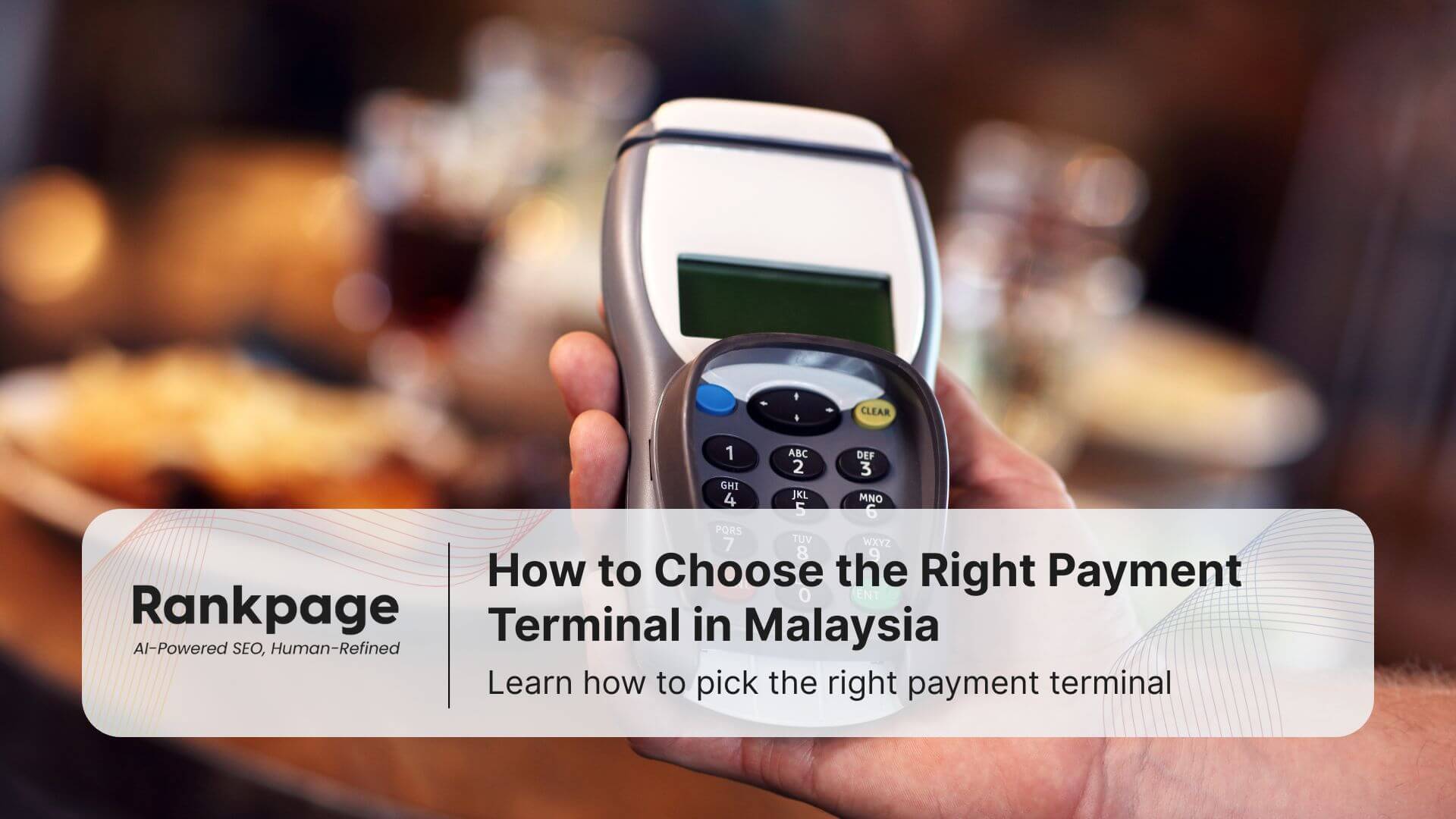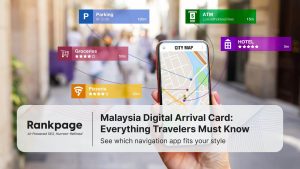Key Takeaways
- A payment terminal lets businesses process cards, QR, and eWallet payments—an essential in Malaysia’s 2025 cashless economy.
- The right choice depends on fees, integration, and customer experience, not just device cost.
- Bank-issued terminals suit high-volume merchants, while independent providers offer faster onboarding and flexibility.
- Watch for hidden fees like settlement delays, early termination penalties, and minimum monthly commitments.
- Your terminal must match your transaction volume, business type, and compliance needs for long-term profitability
A payment terminal is the tool that lets businesses accept cards, DuitNow QR, and eWallet payments securely and instantly.
But here’s the challenge: every bank, fintech, and merchant provider “claims” to have the perfect solution.
Some offer zero hardware costs but charge higher transaction fees. Others give you lower per-transaction rates but tie you into long contracts.
The wrong choice can eat into profits or lock you into a system that doesn’t fit your business.
Today, the leading SEO agency in Malaysia will show you what really matters when choosing a payment terminal, from fees and security to integration and customer experience, so you can make a decision that will benefit your business.
Table of Contents
What is a Payment Terminal
A payment terminal is the secure bridge between your customer’s card or eWallet and your bank account.
When a customer taps, swipes, or scans:
- The terminal encrypts the data.
- It connects to the bank or payment network.
- Authorisation is confirmed in seconds.
- The money settles into your account (usually in 1–3 working days).
They range from mobile POS apps that turn your phone into a card reader to smart terminals with built-in QR and receipt printers.
Most now support Visa, Mastercard, DuitNow QR, GrabPay, Touch ‘n Go, ShopeePay, and other local eWallets.
Who Needs a Payment Terminal in Malaysia?
Before you sign up on any payment provider, weigh these five factors because the cheapest upfront option might end up the most expensive mistake.
1. Watch out for Transaction Fees That Eat Margins
Every swipe, tap, or scan comes with a cut. So always, and we do mean always, ask upfront on the transaction fees.
- Transaction Fees: Bank terminals are usually 0.75%–2.2% in Malaysia. Higher if you’re using fintech aggregators.
- Setup & Monthly Fees: Banks sometimes charge RM500+ upfront, plus monthly minimums.
- Hidden Costs: Settlement delays or early-termination penalties.
A café in Bangsar pulling in 200 small-ticket transactions a day will feel transaction fees more sharply than a luxury boutique selling a few big-ticket items.
2. Know What Your Customers Actually Use
It’s pointless to get a fancy terminal that only accepts cards if your customers pay with eWallets.
- Urban Shoppers: Expect card + eWallets (GrabPay, TNG, ShopeePay).
- Pasar Malam or Bazaar Buyers: DuitNow QR is king.
- Tourists: Still rely heavily on Visa/Mastercard
However, we recommend getting an all-in-one payment gateway that accepts all forms of payment method. It’s just much easier.
3. Look for Integration That Saves You Headaches
Some terminals just process payments while others sync with your POS, accounting, or even delivery apps.
- Less Manual Work: Without integration, you’re stuck cross-checking transactions in Excel at the end of every day.
- Faster Cash Flow Tracking: Real-time syncing with POS or accounting means you know exactly how much came in, which channel it came from, and if settlement matches.
- Cleaner Tax & Audit Trails: For businesses in Malaysia, compliance with LHDN and SST reporting is easier if your systems sync.
“Malaysia’s Service Tax increased to 8% on 1 March 2024, and from 1 July 2025 the government expanded SST scope and adjusted sales tax. Make sure your POS and accounting exports support SST reporting and audits.”
4. Security That’s Bank Negara-Proof
Bank Negara Malaysia (BNM) keeps a tight grip on payment systems, and that’s a good thing. It means most terminals you see offered by banks and licensed fintech providers are already compliant, secure, and reliable.
But a little due diligence can save you from nasty surprises. Here’s what you should look for:
- EMV Chips & Encryption
- EMV chips are the global gold standard against card cloning and fraud.
- Combined with end-to-end encryption, they ensure sensitive data never “sits” on your terminal.
- SIRIM Certification
- Every physical device sold in Malaysia should carry SIRIM approval.
- It’s not just about compliance, it ensures the hardware itself isn’t a dodgy import that fails mid-transaction.
- BNM-Regulated Providers
- Always check that your provider is listed as a licensed payment service under Bank Negara.
- This guarantees your settlements are processed within regulated timelines (no sudden vanishing acts with your money).
5. Flexibility as You Grow
Today you may be handling small orders, but tomorrow you could be handling franchise-level sales.
Your payment terminal shouldn’t hold you back when your business scales and this is a factor you must consider.
- Mobile Vendors (stalls, food trucks, bazaars):
- Tap2Phone or QR-based terminals are affordable and portable.
- Ideal when you’re processing smaller-ticket, high-volume sales.
- Example: A weekend pasar malam seller using QR avoids carrying wads of cash and processes payments faster.
- Expanding SMEs (cafés, retail outlets, clinics):
- Bank terminals often give better per-transaction rates once volume picks up.
- Stronger integration with POS and accounting.
- Example: A suburban café chain in Penang can centralise sales from three outlets into one dashboard.
- Scaling Brands (multi-branch, nationwide retailers):
- Multi-bank providers like Paydibs or SenangPay allow wider acceptance (cards, DuitNow QR, eWallets, cross-border).
- Offer enterprise-level dashboards to manage multiple terminals across branches.
- Example: A pharmacy group with 20 outlets can track settlement from all locations in real time.
Read more: What Is OPR? A Business Guide to Malaysia’s Interest Rate
Should You Choose a Bank-Issued or Independent Terminal?
Your provider matters just as much as the device itself. In Malaysia, you’ll typically face two main choices:
Bank Terminals (Maybank, CIMB, RHB)
- Why They Work: Lower per-transaction fees if your volume is high, strong customer support, and a backbone of established banking infrastructure.
- The Catch: Contracts, setup fees, and longer onboarding times. You’ll need to be patient with paperwork before you can start accepting payments.
- Best Fit: Retailers, clinics, or cafés with steady traffic who value long-term savings and stability.
Example: A high-traffic chain retailer may save thousands annually by sticking with a bank terminal’s lower percentage fees.
Independent Providers (GHL, Storehub, Paydibs)
- Why They Work: Faster onboarding sometimes within days, and broader acceptance of DuitNow QR plus multiple eWallets like GrabPay, TNG, and ShopeePay.
- The Catch: Slightly higher fees and less flexibility to negotiate rates compared to banks.
- Best Fit: Startups, pop-up shops, and small boutiques that need to get up and running quickly without heavy setup costs.
Example: A small boutique owner might choose Paydibs mPOS because it’s quick to deploy and customer-friendly, even if transaction fees are higher.
Match Your Credit Card Machine to Your Business Type
| Business Type | Best Terminal Choice | Why It Works | Local Example |
| Micro-businesses | Mobile terminals (Tap2Phone, QR-based apps) | No hardware fees, portable, accepts QR + cards | A nasi lemak stall at a Ramadan bazaar uses Tap2Phone to cut cash handling. |
| SMEs with steady walk-in traffic | Bank terminals | Lower fees at higher volume, stable support | A small clinic in PJ saves more in the long run with lower per-transaction rates. |
| F&B chains & high-volume retail | Integrated terminals | POS integration, multi-wallet acceptance, centralised reporting | A bubble tea chain syncs sales from all outlets into one dashboard for faster reconciliation. |
Other factors to consider
- Settlement Speed: Does the provider pay out next day or after 2–3 working days? This affects cash flow.
- Customer Support: Is help available 24/7 and in Bahasa/Malay-English, or only through overseas call centres?
- Hardware Reliability: Will you need receipt printers, dual-SIM backup, or Wi-Fi only?
- eWallet Coverage: Not all providers cover every Malaysian wallet (TNG, GrabPay, ShopeePay, Boost). Check what your customers actually use.
- Cross-Border Acceptance: Useful if you cater to tourist, look for Alipay+, UnionPay, or Visa QR.
- Upgrade Options: Can you move from one device tier to another without breaking your contract?
Questions You Should Ask Before Signing a Contract
Asking the right questions upfront prevents expensive surprises and reduces room for disputes later.
Treat the contract as you would a down payment agreement, you wouldn’t sign without checking the fine print, and the same applies here.
Questions to ask:
- What is the exact transaction fee range? (1.3%–2% is common, but can you negotiate lower if volume grows?)
- Are there monthly minimums or penalties for low usage? (Important for seasonal businesses like Ramadan bazaars or year-end pop-ups.)
- How long is the settlement cycle,1, 2, or 3 days? (Cash flow can make or break SMEs, faster is usually better.)
- What are the termination clauses? (Check for early exit fees,some providers lock you in for 24–36 months.)
- Is customer support 24/7 and local? (No one wants to troubleshoot with an overseas call centre who doesn’t understand you.)
- Can it handle all major eWallets (TNG, GrabPay, ShopeePay)? (Don’t assume, it’s better to confirm.)
- Does the device integrate with my POS or accounting system? (Saves hours of reconciliation each month.)
Of course, not every provider will tick every box, it would be great, but not needed.
The goal isn’t to find a “perfect” terminal, it’s to find one that matches your business size, customer behaviour, and growth stage.
Payment Terminals as Business Enablers
By weighing fees, support, and integration, businesses can avoid costly lock-ins and make sure their cashiers don’t have to fumble for loose changes or sense.
But remember, the “best” choice isn’t about chasing the cheapest option, but choosing what fits with your business model, customer expectations, and current POS systems you have.
And just as selecting the right terminal shapes how your customers pay, the right SEO service helps shape how customers find you online.
So, if you plan on getting a new payment terminal, why not pair it with visibility too? With SEO bringing in the large crowd and your shiny new terminal processing the sales, it’s a win-win.
Frequently Asked Questions About Payment Terminals in Malaysia
What Is The Difference Between A POS And A Payment Terminal?
A POS manages sales and inventory, a payment terminal processes payments only.
How Much Does A Payment Terminal Cost In Malaysia?
Devices range from RM200–1,500, with transaction fees of 1.3%–2%.
Can I Use My Phone As A Payment Terminal?
Yes, solutions like Tap2Phone allow Android phones to accept contactless payments.
What’s The Best Terminal For Pop-Ups?
Tap-to-Phone or QR-first Android smart POS with DuitNow QR (covers TNG, GrabPay, ShopeePay). Target T+1 settlement, dual-SIM for bazaars, and POS-lite reporting.
How Long Does Settlement Take?
Between 1–3 working days depending on provider, always ask to confirm.
How fast can I go live?
Varies by provider. Some in-store solutions advertise go-live in 2 hours post-approval. Have your KYC docs ready and confirm batch cut-off to enable T+1 settlement.





